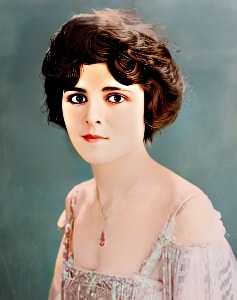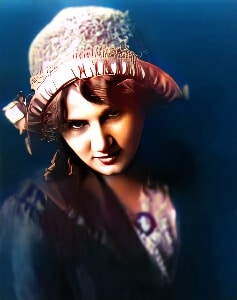 Alla Nazimova, born Marem-Ides Leventon on June 3, 1879, in Yalta, Crimea, is a name synonymous with the golden age of silent cinema.
Alla Nazimova, born Marem-Ides Leventon on June 3, 1879, in Yalta, Crimea, is a name synonymous with the golden age of silent cinema.
An enigmatic and multifaceted actress, she made her mark not only for her captivating performances but also for her influence on the artistic and creative aspects of filmmaking during the early 20th century.
Nazimova’s journey to stardom began on the stages of Russia. She received formal training at the Imperial Academy of Dramatic Arts in Moscow and later joined the Moscow Art Theatre, where she honed her craft and gained acclaim as a stage actress. Her early career in Russia introduced her to the works of playwrights like Anton Chekhov and Leo Tolstoy, setting the stage for her success as an actress in the United States.
In 1905, she emigrated to the United States and began performing on Broadway. Her performances received critical praise, and she quickly became a sought-after actress in New York’s vibrant theater scene. Her early success in American theater paved the way for her entry into the world of silent cinema.
Nazimova made her silent film debut in 1916 in “War Brides,” directed by Herbert Brenon. However, it was her role in “Revelation” (1918), directed by George D. Baker, that catapulted her to cinematic stardom. Her ability to convey complex emotions, particularly on screen, was remarkable, and she was recognized for her acting talent.
One of the defining moments in Nazimova’s career was her adaptation of Oscar Wilde’s one-act play “ Salomé” for the silver screen. She produced and starred in the 1922 film, which bore her name in the title credits. “ Salome” is renowned for its avant-garde art direction, symbolist aesthetic, and provocative themes. Nazimova’s performance as Salome is considered one of her most mesmerizing and iconic roles.
Nazimova’s influence extended beyond acting. She was known for her creative collaborations and the artistic freedom she enjoyed in her work. Her partnership with designer Natacha Rambova, who also became her life partner, resulted in visually stunning and innovative films. Nazimova’s home, the Garden of Alla, served as a gathering place for artists and intellectuals of the era, making it a hub for creative collaboration.
While her artistic pursuits were groundbreaking, Nazimova’s personal life was marked by complexity. She kept her relationships and identity relatively private in an era when being open about one’s sexuality was challenging. Her unconventional lifestyle was a topic of discussion in the media, and her non-conformity to societal norms was both a source of fascination and controversy.
As the silent era transitioned into the age of sound cinema, many silent film stars faced challenges adapting to the new medium. Nazimova made the shift to sound films but was not as prominent in this era, despite her talent. Her final screen appearance was in “Mourning Becomes Electra” (1947), directed by Dudley Nichols.
Alla Nazimova’s impact on the world of cinema and the performing arts endures. Her performances continue to be celebrated for their depth and authenticity, and her influence on art direction and cinematography is acknowledged. She remains an icon of silent cinema, remembered for her enigmatic screen presence, artistic collaborations, and her contribution to the early days of Hollywood. Her legacy as a pioneering figure in the world of cinema and the performing arts continues to be a source of inspiration for generations of artists and filmmakers.

 Alla Nazimova, born Marem-Ides Leventon on June 3, 1879, in Yalta, Crimea, is a name synonymous with the golden age of silent cinema.
Alla Nazimova, born Marem-Ides Leventon on June 3, 1879, in Yalta, Crimea, is a name synonymous with the golden age of silent cinema.


